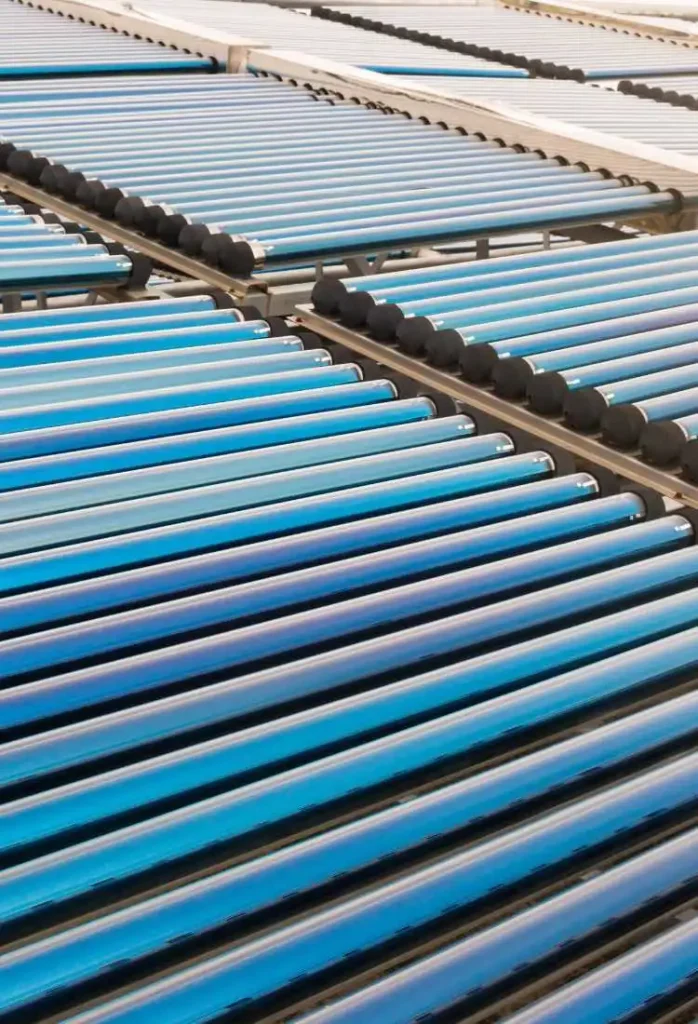Heating and cooling networks

Industrial
In the industrial context, DHCs focus on optimizing the production and use of thermal energy for specific processes. Here are some of the key features and benefits:
- Heat Recovery: Many industrial processes generate waste heat that, under normal circumstances, would be wasted. DHCs can capture this heat and redistribute it for use in other processes within the same plant or in nearby facilities, improving overall energy efficiency.
- Efficient Processes: Industries that require large amounts of heat or cooling for their operations can benefit significantly from a DHC, as it provides a constant, adjustable source of thermal energy that can be precisely matched to their needs.
- Sustainability: Integrating renewable energy sources, such as solar thermal, geothermal or biomass, into an industrial DHC helps reduce dependence on fossil fuels and reduce carbon emissions.

City
In cities, DHCs are primarily used to improve energy efficiency and sustainability in the heating and cooling of residential, commercial and public buildings. Here are some highlights:
- District Heating and Cooling: Implementing DHC in urban areas allows multiple buildings to share a centralized source of heating and cooling, which reduces operating costs and improves energy efficiency compared to individual systems.
- Flexibility and Scalability: DHC’s urban grids can be easily expanded to include new buildings or integrate new renewable energy sources, making them highly adaptable to changing city needs.
- Resilience and Reliability: Urban DHCs offer greater reliability in the supply of thermal energy, crucial for maintaining the comfort and safety of residents, especially during peak demand or extreme weather conditions.
Green energy solutions

Hybrid solar panel
Hybrid solar panels, also known as photovoltaic-thermal solar panels (PVT), are an innovative technology that combines photovoltaic (PV) electricity generation with heat production (thermal) in a single integrated system. This combination allows more efficient use of the sun’s energy, generating both electricity and heat from the same surface area, which improves the overall performance of the solar system and optimizes the space used for the installation.
How do hybrid solar panels work?
The operation of hybrid solar panels is based on the integration of two technologies:
Photovoltaic (PV): The photovoltaic part of the panels uses solar cells, typically silicon, which convert sunlight into electricity through the photovoltaic effect. When sunlight strikes the PV cells, an electric current is generated due to the excitation of electrons within the semiconductor material of the panel.
Thermal: The thermal section of the panel takes advantage of the heat generated by the PV cells, which would normally be wasted to the air. This heat is collected by a heat transfer fluid (water or a mixture of water and glycol) that circulates through pipes integrated in the panel or located behind the PV cells. This heat can be used to produce domestic hot water, heating, or even for cooling processes through absorption systems.
Vacuum tube collector
Evacuated tube collectors are a technology used in solar heating systems to capture the sun’s energy and convert it into heat. This type of solar collector is especially effective for operating in cold climates and cloudy days, offering high efficiency in converting solar energy into thermal energy. Its unique design allows solar energy to be harnessed more efficiently compared to flat-plate solar thermal panel systems.
What are evacuated tube collectors?
A evacuated tube collector consists of a series of cylindrical glass tubes that function as solar thermal collectors. These tubes are made of two layers of glass with a vacuum between them to act as a thermal insulator. This vacuum almost completely reduces heat losses by convection and conduction, making these collectors very efficient even in conditions of low solar radiation and low outdoor temperatures.
How do they work?
Solar Energy Absorption: Each vacuum tube contains an absorber (absorbing material) that captures solar radiation. This absorber is designed to capture a wide range of solar radiation, including visible, infrared and ultraviolet light.
Heat Transfer: Inside the vacuum tube, and in direct contact with the absorber, there is a heat pipe or conduit through which a heat transfer fluid circulates. This fluid is heated by the absorbed solar energy and transfers the heat to the water or fluid circulating in the solar heating system circuit.
Thermal Insulation: The vacuum between the two layers of glass in the tubes acts as an extremely effective insulator, minimizing heat losses. This allows evacuated tube collectors to be efficient even on cold or windy days, unlike other types of solar collectors that can lose a significant amount of heat under these conditions.


CSP: Concentrated solar power
Concentrated solar power (CSP) is a technology that uses mirrors or lenses to concentrate a large amount of sunlight onto a small receiver. This concentrated solar energy heats a fluid, which is then used to generate electricity in a conventional thermal cycle process. CSP is remarkably effective in areas with high direct solar irradiation and is used primarily in large-scale applications to generate electricity for power grids.
How does Concentrated Solar Power work?
The operation of CSP systems is based on four main components: the solar collector field, the heat receiver, the energy conversion system and the thermal storage system.
Solar Collector Field: Uses mirrors or lenses to concentrate sunlight. There are several types of concentrating technologies, including solar towers, parabolic troughs, parabolic dish systems, and linear Fresnel systems. Each has a different way of concentrating sunlight onto a receiver.
Heat Receiver: Concentrated sunlight is directed towards a receiver, where a heat transfer fluid is heated. This fluid can reach very high temperatures, often above 400 °C (750 °F).
Energy Conversion System: Hot fluid is used to generate steam in a heat exchanger. The steam generated is directed to a steam turbine, where the thermal energy is converted into mechanical energy and then into electrical energy by a generator.
Thermal Storage System: Thermal energy can be stored, often in the form of molten salts, allowing the plant to generate electricity when sunlight is not available, such as at night or on cloudy days. This improves the reliability and availability of power generated by CSP facilities.
Cooling and Heating Distribution Networks
Heating and Cooling Distribution Networks (DHC) represent an advanced and sustainable solution for thermal energy management in urban and industrial environments. By centralizing heat and cooling production, these networks facilitate efficient distribution to multiple users, optimizing energy consumption and reducing environmental impact. Below, we break down what DHCs are, how to implement them, their applications and the advantages they offer both at an industrial level and in the development of smart cities.
What are Heat and Cooling Networks (DHC)?
A Heat and Cooling Network is a centralized system that produces and distributes thermal energy in the form of hot or chilled water through a network of insulated pipes to meet the heating, cooling or hot water needs of buildings and industrial processes. This centralized approach allows for greater efficiency and control compared to individual systems.
Implementation of a DHC Network
The implementation of a DHC network requires detailed planning:
- Feasibility study: Analysis of the target area or industry, evaluating thermal energy demand and existing infrastructure.
- System design: Definition of the energy source (can be renewable or waste heat recovery), production capacity and layout of the distribution network.
- Construction and installation: Development of the central production infrastructure and the piping network that will connect to the buildings or industrial facilities.
- Operation and maintenance: Establishment of a management system to operate the network efficiently and perform preventive and corrective maintenance.
Industrial Applications
DHC networks have wide applications in industry, such as:
- Manufacturing processes: Where heat is required for production processes or cold for preservation and processing of materials.
- Heat recovery: Use of waste heat from industrial processes for reuse in the grid.
City Applications
DHCs are fundamental in the development of smart cities, enabling:
- District heating and cooling: Efficient supply to residential, commercial and public complexes.
- Integration with renewable energies: Facilitates the transition to clean energy sources by integrating with solar thermal, geothermal or biomass systems.
Advantages of DHC Networks
- Energy efficiency: Reduction of primary energy consumption and CO2 emissions.
- Flexibility and scalability: Ability to adapt to new technologies and renewable energy sources.
- Reliability: Constant supply of heating and cooling, improving comfort and productivity.
Profitability and Investment
The cost-effectiveness of DHC networks depends on factors such as initial cost, savings in energy consumption and government incentives. Although the initial investment may be high, the operational efficiencies and long-term benefits in terms of energy savings and emissions reductions make DHC networks an attractive and sustainable investment.
Heat and Cooling Networks emerge as a key solution to face the energy and environmental challenges of our times. Their implementation in industries and cities not only promotes energy efficiency and sustainability, but also represents a strategic investment towards a greener and economically viable future.
